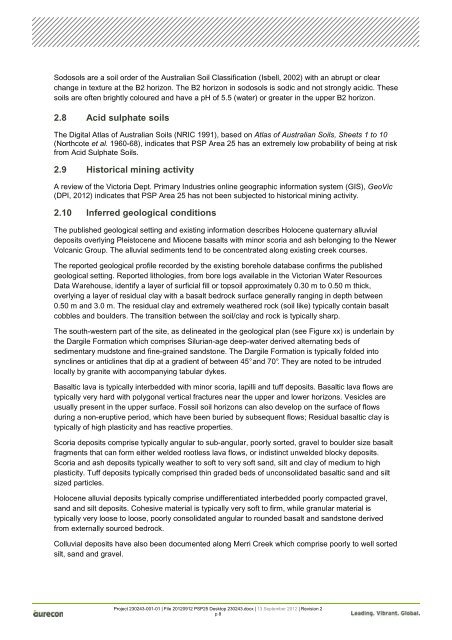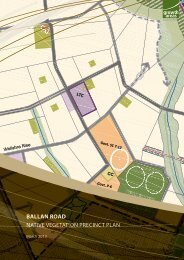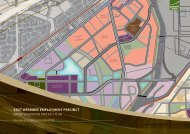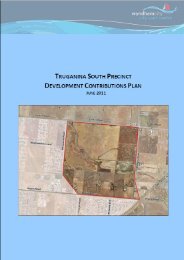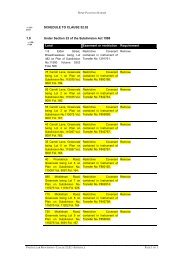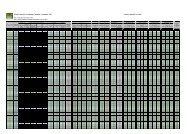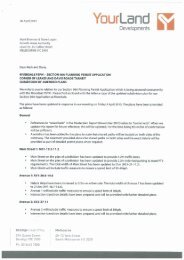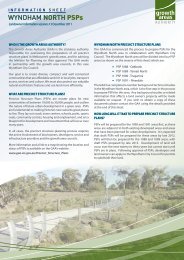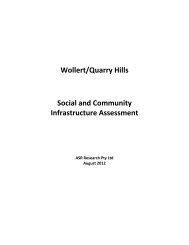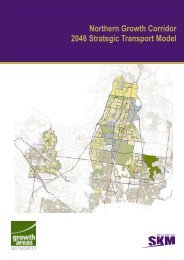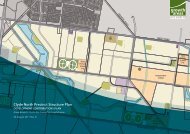Desktop Environmental, Hydrological and Geotechnical Study
Desktop Environmental, Hydrological and Geotechnical Study
Desktop Environmental, Hydrological and Geotechnical Study
Create successful ePaper yourself
Turn your PDF publications into a flip-book with our unique Google optimized e-Paper software.
Sodosols are a soil order of the Australian Soil Classification (Isbell, 2002) with an abrupt or clear<br />
change in texture at the B2 horizon. The B2 horizon in sodosols is sodic <strong>and</strong> not strongly acidic. These<br />
soils are often brightly coloured <strong>and</strong> have a pH of 5.5 (water) or greater in the upper B2 horizon.<br />
2.8 Acid sulphate soils<br />
The Digital Atlas of Australian Soils (NRIC 1991), based on Atlas of Australian Soils, Sheets 1 to 10<br />
(Northcote et al. 1960-68), indicates that PSP Area 25 has an extremely low probability of being at risk<br />
from Acid Sulphate Soils.<br />
2.9 Historical mining activity<br />
A review of the Victoria Dept. Primary Industries online geographic information system (GIS), GeoVic<br />
(DPI, 2012) indicates that PSP Area 25 has not been subjected to historical mining activity.<br />
2.10 Inferred geological conditions<br />
The published geological setting <strong>and</strong> existing information describes Holocene quaternary alluvial<br />
deposits overlying Pleistocene <strong>and</strong> Miocene basalts with minor scoria <strong>and</strong> ash belonging to the Newer<br />
Volcanic Group. The alluvial sediments tend to be concentrated along existing creek courses.<br />
The reported geological profile recorded by the existing borehole database confirms the published<br />
geological setting. Reported lithologies, from bore logs available in the Victorian Water Resources<br />
Data Warehouse, identify a layer of surficial fill or topsoil approximately 0.30 m to 0.50 m thick,<br />
overlying a layer of residual clay with a basalt bedrock surface generally ranging in depth between<br />
0.50 m <strong>and</strong> 3.0 m. The residual clay <strong>and</strong> extremely weathered rock (soil like) typically contain basalt<br />
cobbles <strong>and</strong> boulders. The transition between the soil/clay <strong>and</strong> rock is typically sharp.<br />
The south-western part of the site, as delineated in the geological plan (see Figure xx) is underlain by<br />
the Dargile Formation which comprises Silurian-age deep-water derived alternating beds of<br />
sedimentary mudstone <strong>and</strong> fine-grained s<strong>and</strong>stone. The Dargile Formation is typically folded into<br />
synclines or anticlines that dip at a gradient of between 45° <strong>and</strong> 70°. They are noted to be intruded<br />
locally by granite with accompanying tabular dykes.<br />
Basaltic lava is typically interbedded with minor scoria, lapilli <strong>and</strong> tuff deposits. Basaltic lava flows are<br />
typically very hard with polygonal vertical fractures near the upper <strong>and</strong> lower horizons. Vesicles are<br />
usually present in the upper surface. Fossil soil horizons can also develop on the surface of flows<br />
during a non-eruptive period, which have been buried by subsequent flows; Residual basaltic clay is<br />
typically of high plasticity <strong>and</strong> has reactive properties.<br />
Scoria deposits comprise typically angular to sub-angular, poorly sorted, gravel to boulder size basalt<br />
fragments that can form either welded rootless lava flows, or indistinct unwelded blocky deposits.<br />
Scoria <strong>and</strong> ash deposits typically weather to soft to very soft s<strong>and</strong>, silt <strong>and</strong> clay of medium to high<br />
plasticity. Tuff deposits typically comprised thin graded beds of unconsolidated basaltic s<strong>and</strong> <strong>and</strong> silt<br />
sized particles.<br />
Holocene alluvial deposits typically comprise undifferentiated interbedded poorly compacted gravel,<br />
s<strong>and</strong> <strong>and</strong> silt deposits. Cohesive material is typically very soft to firm, while granular material is<br />
typically very loose to loose, poorly consolidated angular to rounded basalt <strong>and</strong> s<strong>and</strong>stone derived<br />
from externally sourced bedrock.<br />
Colluvial deposits have also been documented along Merri Creek which comprise poorly to well sorted<br />
silt, s<strong>and</strong> <strong>and</strong> gravel.<br />
Project 230243-001-01 | File 20120912 PSP25 <strong>Desktop</strong> 230243.docx | 13 September 2012 | Revision 2<br />
p 8


